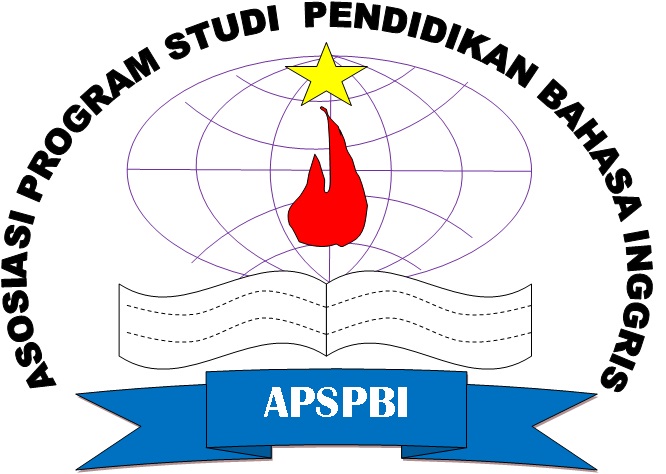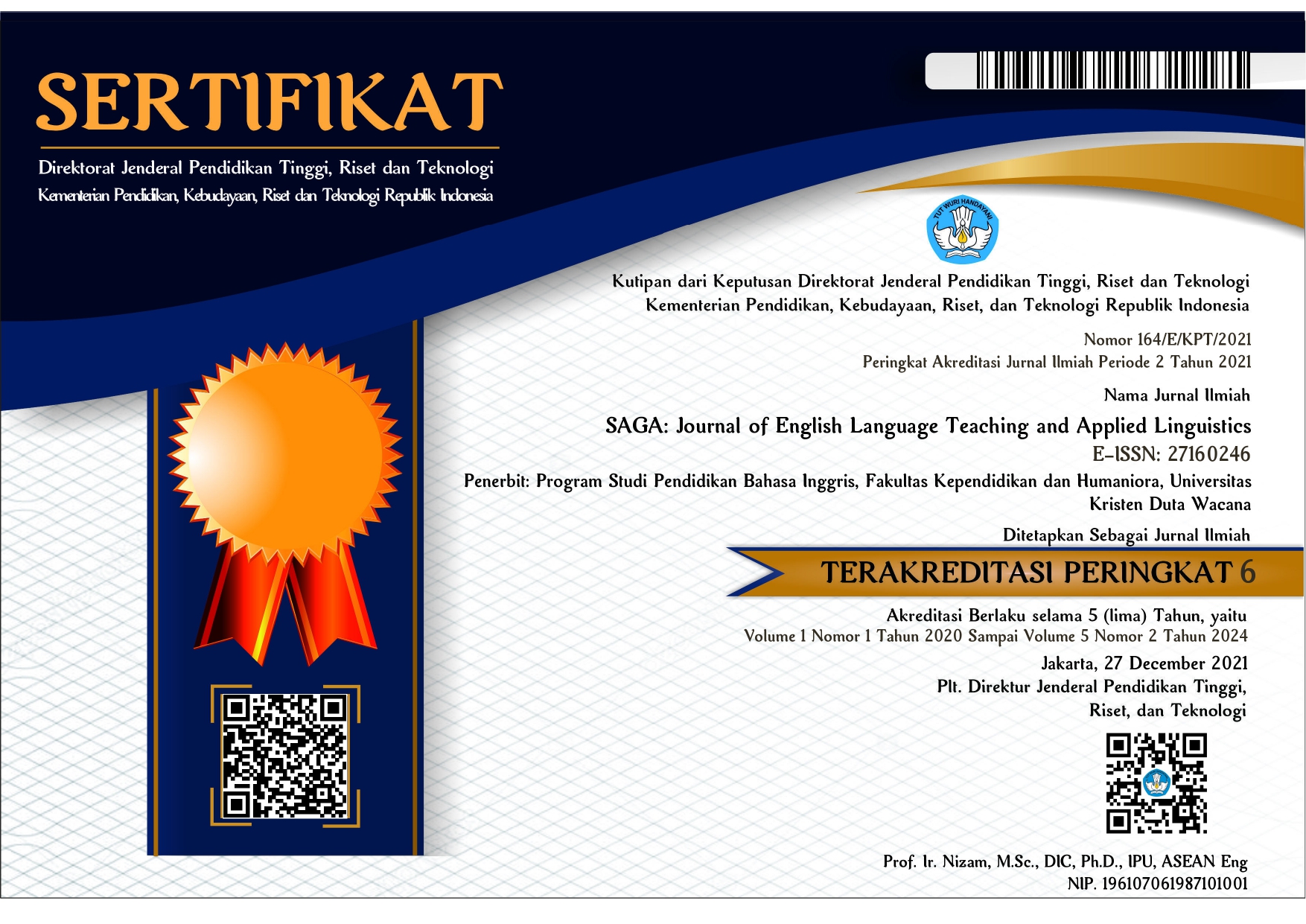Investigating Indonesian EFL Teachers’ Perceptions on Blended Learning Strategy Amid Post-Covid-19 Era
DOI:
https://doi.org/10.21460/saga.2022.31.118Keywords:
Blended learning strategy, EFL teachers’ perceptions, post- covid-19 eraAbstract
One of the good news of the new normal era is all humankind’s sectors are opened gradually by following the restricted health protocols. Without an exception, the educational sector is also allowed by the government to open schools in the green zone. As a result, a blended learning strategy is inevitably essential to support this post-covid-19 era. Blended learning strategy is a novel pedagogical approach where the online and offline systems are combined to promote more purposeful, organized, and meaningful learning dynamics for learners. This current small-scale qualitative study aimed to investigate the specific benefits of a blended learning strategy based on Indonesian EFL teachers’ perceptions. Thus, 5 open-ended written narrative inquiry questions were sent to two randomly invited Indonesian EFL teachers working in different elementary school institutions. The obtained research results unveiled that the effective utilization of blended learning strategy had successfully promoted more meaningful language learning enterprises, elevated EFL learners’ learning motivation, and increased their proactive learning behaviors. However, it should also be pondered carefully that the more contextualized language learning approaches, as well as stable internet connection, are urgently needed to strengthen the effectiveness of this learning approach. Due to the obtained research results, it is reasonable to be expected that Indonesian EFL experts, teachers, practitioners, and policy-makers can establish more collaborative networking to better design more qualified and meaningful blended learning activities in the future.
References
Adedoyin, O. B., & Soykan, E. (2020). Covid-19 pandemic and online learning: the challenges and opportunities. Interactive Learning Environments, 0(0), 1–13. https://doi.org/10.1080/10494820.2020.1813180
Aji, W. K., Ardin, H., & Arifin, M. A. (2020). Blended Learning During Pandemic Corona Virus: Teachers’ and Students’ Perceptions. IDEAS: Journal on English Language Teaching and Learning, Linguistics and Literature, 8(2), 632–646. https://doi.org/10.24256/ideas.v8i2.1696
Aldosemani, T., Shepherd, C. E., & Bolliger, D. U. (2019). Perceptions of Instructors Teaching in Saudi Blended Learning Environments. TechTrends, 63(3), 341–352. https://doi.org/10.1007/s11528-018-0342-1
Arifani, Y., Khaja, F. N. M., Suryanti, S., & Wardhono, A. (2019). The Influence of Blended In-service Teacher Professional Training on EFL Teacher Creativity and Teaching Effectiveness. 3L: Language, Linguistics, Literature, 25(3), 126–136. https://doi.org/10.17576/3L-2019-2503-10
Asarta, C. J., & Schmidt, J. R. (2020). The effects of online and blended experience on outcomes in a blended learning environment. Internet and Higher Education, 44(September 2018), 100708. https://doi.org/10.1016/j.iheduc.2019.100708
BakarNordin, A., & Alias, N. (2013). Learning Outcomes and Student Perceptions in Using of Blended Learning in History. Procedia - Social and Behavioral Sciences, 103, 577–585. https://doi.org/10.1016/j.sbspro.2013.10.375
Boelens, R., De Wever, B., & Voet, M. (2017). Four key challenges to the design of blended learning: A systematic literature review. Educational Research Review, 22, 1-18.
Chandler, T., Park, Y. S., Levin, K. L., & Morse, S. S. (2013). The incorporation of hands-on tasks in an online course: An analysis of a blended learning environment. Interactive Learning Environments, 21(5), 456–468. https://doi.org/10.1080/10494820.2011.593524
Chang-Tik, C. (2018). Impact of learning styles on the community of inquiry presences in multidisciplinary blended learning environments. Interactive Learning Environments, 26(6), 827–838. https://doi.org/10.1080/10494820.2017.1419495
Ciptaningrum, M. A. B. and D. S. (2019). Suggested Blended Learning Models To Teach English. The 5th International LLTC Proceedings, February, 53–60.
Clandinin, D. J., & Caine, V. (2013). Narrative inquiry. Reviewing Qualitative Research in the Social Sciences, 166–179. https://doi.org/10.4324/9780203813324-13
Sakina, R., Kulsum, E. M., & Syaepul Uyun, A. (2020). Integrating Technologies in the New
Normal: A Study of Blended Learning. International Journal of Quantitative Research and Modeling, 1(4), 183–193. https://doi.org/10.46336/ijqrm.v1i4.90
Sari, F. M., & Wahyudin, A. Y. (2019). Blended-Learning: The Responses from Non-English Students in the Indonesian Tertiary Context. Teknosastik, 17(1), 23. https://doi.org/10.33365/ts.v17i1.204
Setyaningsih, E. (2020). Face-to-face or online learning : Students ’ perspectives on blended
learning in Indonesia. Journal of English Language Studies, 5(1), 1–14.
Shivam, R., & Singh, S. (2015). Implementation of Blended Learning in Classroom: A review paper. International Journal of Scientific and Research Publications, 5(11), 369-372.
Smith, K., & Hill, J. (2019). Defining the nature of blended learning through its depiction in
current research. Higher Education Research and Development, 38(2), 383–397. https://doi.org/10.1080/07294360.2018.1517732
Tamim, R. M. (2018). Blended Learning for Learner Empowerment: Voices from the Middle
East. Journal of Research on Technology in Education, 50(1), 70–83. https://doi.org/10.1080/15391523.2017.1405757
Wang, Y., Han, X., & Yang, J. (2015). Revisiting the blended learning literature: Using a complex adaptive systems framework. Educational Technology and Society, 18(2), 380–393.
Zaim, M., & Mudra, H. (2019). Blended English language learning as a course in an Indonesian context: An exploration toward EFL learners’ perceptions. PervasiveHealth: Pervasive Computing Technologies for Healthcare, Part F148151, 209–216. https://doi.
org/10.1145/3318396.3318435
Zainuddin, Z., & Attaran, M. (2016). Malaysian students’ perceptions of flipped classroom: a
case study. Innovations in Education and Teaching International, 53(6), 660–670. https://doi.org/10.1080/14703297.2015.1102079
















